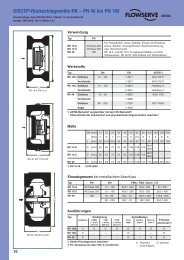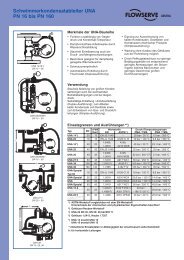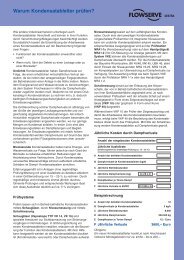MAFUND®
MAFUND®
MAFUND®
Create successful ePaper yourself
Turn your PDF publications into a flip-book with our unique Google optimized e-Paper software.
TECHNICAL DATA<br />
Dimensions: 500 x 250 x 25 mm<br />
Load: 2-20 N/cm² ≈ 0,2-2 kp/cm²<br />
in special cases<br />
40 N/cm² ≈ 4 kp/cm²<br />
TECHNICAL MATTERS<br />
The <strong>MAFUND®</strong>-Pad consists of a<br />
permanently resistant elastic special material<br />
with correspondingly proportioned air ducts.<br />
The dimensioning of the <strong>MAFUND®</strong>-Pad<br />
depends on the excitation frequency to be<br />
isolated. The diagram in Fig. 4 gives<br />
information about the resonant frequencies of<br />
the <strong>MAFUND®</strong>-Pad in dependence on the<br />
specific loading pressure. It shows relatively<br />
low resonant frequencies under various<br />
loadings. That is the reason why the<br />
<strong>MAFUND®</strong>-Pad is useable for a wide range of<br />
excitation frequencies.<br />
The relation between frequency ratio<br />
L=/f o - (f = excitation frequency, f o = resonant<br />
frequency) - and the degree of isolation is<br />
shown in Fig. 5 It is evident, that an isolation<br />
effect occurs only starting from a tuning ratio<br />
f/f o > 2. In this case we speak of an<br />
"overcritical" support.<br />
In case of an "undercritical" support -<br />
f/f o < 2 - there is no isolation effect for the<br />
basic frequency - number of revolutions of the<br />
machine - to be expected. As the sound<br />
frequencies are mostly much higher than the<br />
basic frequency - number of oscillatory Im<br />
pulses = excitation frequency - it is obvious.<br />
that also in case of "undercritical" support a<br />
good noise isolation can be obtained. If we<br />
consider, that forces and momentums due to<br />
the mass cause a great number of harmonic<br />
vibrations, it is explicable that even in case of<br />
an "undercritical" support a isolation effect is<br />
achieved, because thus amplitudes of the<br />
excitation frequencies, so to peak, are cut off.<br />
MAFUND ®<br />
Static module of<br />
elasticity: E st = 324 N/cm² ≈ 33 kp/cm²<br />
Dynamic module of<br />
elasticity: E d = 441 N/cm² ≈ 45 kp/cm²<br />
Springing: see Load deflection curve Fig.3<br />
Resonant frequency: see curves Fig. 4<br />
Temperature range: -20°C to +80°C<br />
Standard weight: ≈ 3 kp<br />
1 Newton (N) = 0,102 kp<br />
Fig. 3<br />
Load deflection curve of the <strong>MAFUND®</strong>-Pad<br />
Deflection in mm<br />
5<br />
4,5<br />
4<br />
3,5<br />
3<br />
2,5<br />
2<br />
1,5<br />
1<br />
0,5<br />
5 10 15 20 25 30 35 40 45 50<br />
Fig. 4<br />
Resonant frequencies of the <strong>MAFUND®</strong>-Pad<br />
Resonant frequency f o in Hz<br />
24<br />
23<br />
22<br />
21<br />
20<br />
19<br />
18<br />
17<br />
16<br />
15<br />
14<br />
13<br />
12<br />
11<br />
1 Layer<br />
10<br />
9<br />
8<br />
2 Layer<br />
7<br />
3 Layer<br />
6<br />
5<br />
4<br />
4 Layer<br />
3<br />
2<br />
1<br />
0 5 10 15 20 25 30 35 40 45 50 55 60<br />
Loading in N/cm²<br />
Fig. 5<br />
Degree of isolation in dependence to the<br />
relation of frequencies<br />
Oscillation isolation (dB)<br />
25<br />
24<br />
23<br />
22<br />
21<br />
20<br />
19<br />
18<br />
17<br />
16<br />
15<br />
14<br />
13<br />
12<br />
11<br />
10<br />
9<br />
8<br />
7<br />
6<br />
5<br />
4<br />
3<br />
2<br />
1<br />
1,5 1,7 1,9 2,2 2,6 3 3,5 4 4,5 5 6 7<br />
Ratio of frequencies λ = f<br />
f o<br />
94,4<br />
93,7<br />
93<br />
92<br />
91<br />
90<br />
89<br />
87,5<br />
86<br />
84<br />
82<br />
80<br />
78<br />
75<br />
72<br />
68<br />
64<br />
60<br />
55<br />
50<br />
44<br />
37<br />
29<br />
21<br />
11<br />
Degree of isolation (%)






